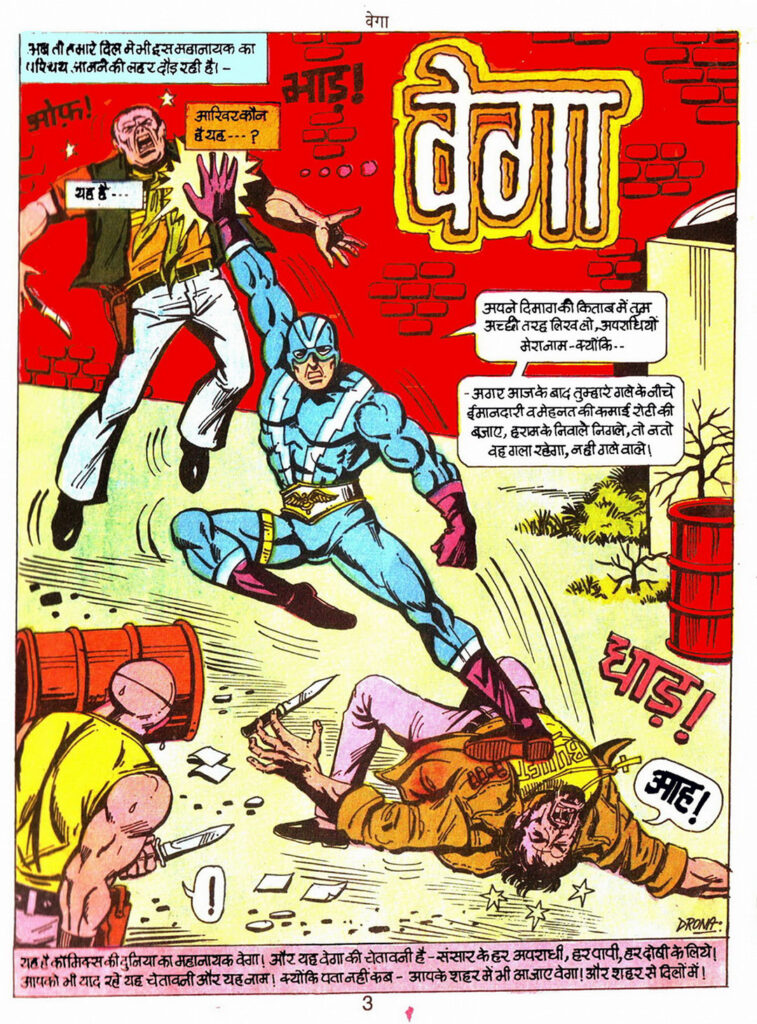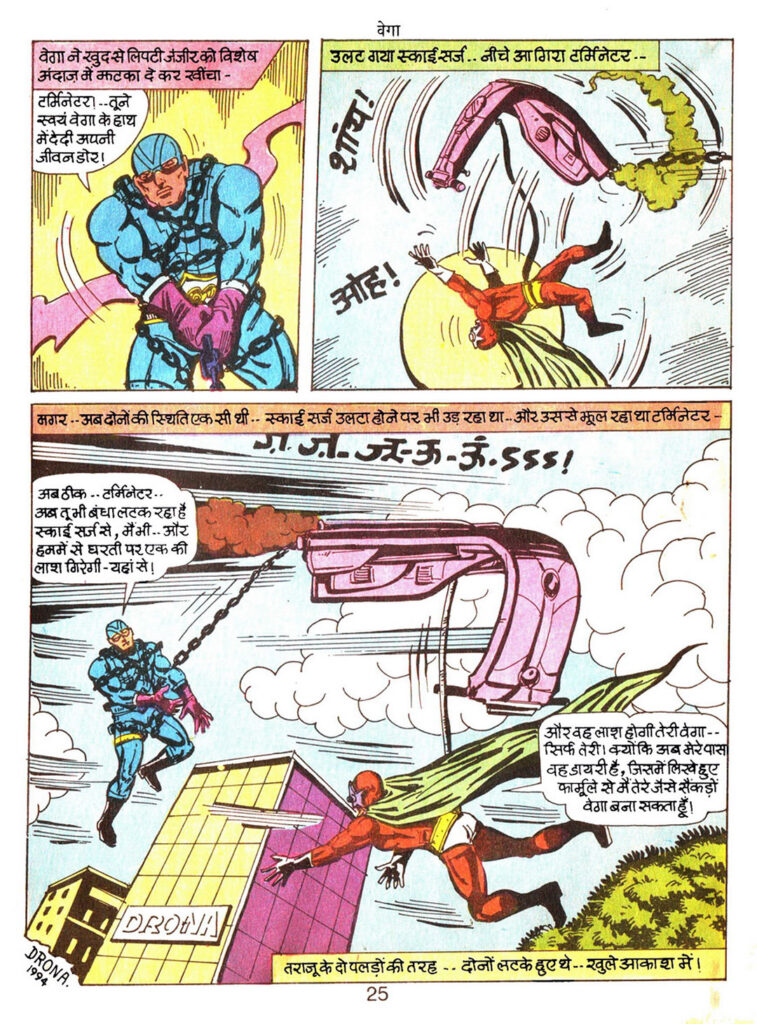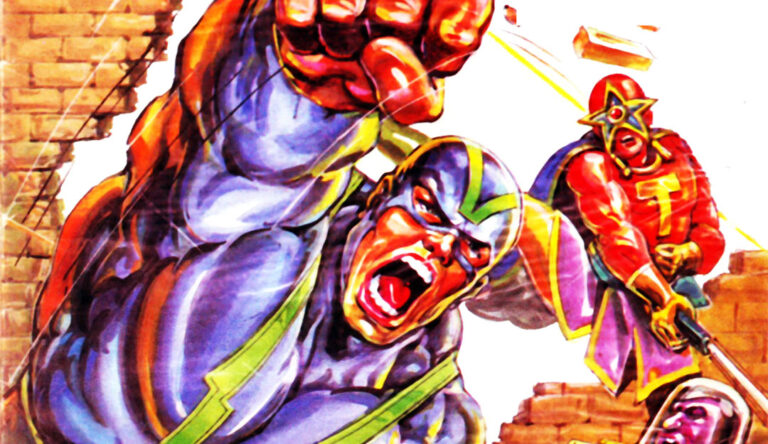In today’s digital age, where countless means of entertainment are present at our fingertips, it is no less than a pleasant experience to pause for a moment and remember the period when pictures and words printed on paper pages used to give wings to our imagination. A precious link to this golden era is Vega, published by King Comics. This work by writer Tikaram Sidhvi and illustrator Drona Features takes us back to that 90s world of action, adventure, and justice, which seems just as impressive today. Here is a detailed review of Vega, taking a deep dive into its world.
Plot: A classic struggle of good and evil
The story of Vega stands on a simple but effective foundation like any superhero comic — the victory of good over evil. The story begins in the dark alleys of crime, where oppression and injustice prevail. The author makes it clear in the very first line that, “Truth can happen anywhere! The snake in the form of crime can raise its hood anywhere.” And whenever this happens, a hand rises — Vega’s hand.

The first part of the story offers an introduction to Vega and a glimpse of his powers. He is a name that instills fear among ordinary goons and criminals. His warning — “If after today, instead of bread, the honest and hard-earned money is swallowed under your neck, there will remain neither a throat nor a neck!” — shows the core of his character. He not only punishes criminals but also provides them an opportunity to reform.
The story takes a real turn when a mysterious and destructive weapon, War-Wheel-IX, lands near the Tara Research Centre. This giant, the drum of death spinning on wheels, destroys everything in its path. Here, the scale of the story goes beyond street goons to a major threat to national security. The country’s top scientists and security personnel become helpless in the face of this devastation. Behind this massacre is the hand of a sinister villain, Sky Surge (also known as The Terminator), who does not want to let a scientist named Doctor Gosha escape from his clutches.
Vega makes an explosive entry to save Doctor Gosha’s life. From here, the comic reaches a new level of action and adventure. The conflict between Vega and War-Wheel, followed by his confrontation with Lederman, and finally his mega-encounter with the main villain Sky Surge, keeps the story engaging for the reader until the end. The pace of the plot is fast, and a new twist or a new action sequence on every page piques the reader’s curiosity. The story ends with Vega’s triumph and his resolve to protect humanity — the essence of a perfect superhero story.
Characterization: A perfect hero and a sinister villain
Vega: Vega is a perfect example of a 90s Indian superhero. His character is strong, just, and powerful. His blue dress, face mask, and stocky body give him the appearance of a classic superhero. His powers are also unique. He is not just physically strong, but the strong wind emanating from his hands gives him the ability to fly and throw away enemies. This ‘Veg’ is his identity, and perhaps this is why he got the name ‘Vega’. He is a protector, a messiah, who reaches anywhere at the call of the innocent. His character is not very deep; there is no internal conflict shown in him, but according to that period, he is a complete hero who has only one goal — the destruction of evil.
Sky Surge (Terminator): A superhero is only as good as his villain. Sky Surge meets this criterion. His face hidden behind a star-shaped mask, his red dress, and weapons with advanced technology make him a dangerous enemy. He is cruel, arrogant, and powerful. He does not hesitate to eliminate anyone who comes his way. He has his own army and gives Vega a tough fight. His and Vega’s final confrontation is the most exciting part of the comic, spreading from the city’s high-rise buildings to the massive tower of electricity.
Supporting Characters: Doctor Gosha plays a frightened, helpless scientist who wants to escape the clutches of the villain. He acts as an important catalyst in moving the story forward. Lederman and the other hooligans serve as vehicles for demonstrating Vega’s powers as the main villain’s henchmen.
Art and Painting: The Magic of Drona Features
The soul of any comic is its drawing, and in this case, Vega does not disappoint. The work of Drona Features is an excellent example of the comic art of that period.
Action and Movement: The artist has illustrated the action scenes with great liveliness and speed. Vega’s punches, his style of flying, the devastation of the War-Wheel, and the hail of bullets — every panel is full of energy. “Drum!”, “Ghadam!”, “Wheesh!”, “Crack!” — words with sound effects (onomatopoeia) combined with pictures make the action even more effective.

Use of Colors: The use of colors in the comic is very lively. The use of primary and bright colors like blue for the hero and red for the villain clearly shows the difference between good and evil. The use of yellow and orange colors for explosions and energy rays makes the scenes even more dramatic.
Panel Layout: The layout of the panels is simple but effective. The story is told in a straight line, making it easier for the reader to understand the sequence of events. Close-up shots have been used successfully to convey the characters’ emotions (anger, fear, determination), while wide-angle panels depict the scale of mayhem and action.
Writing and Dialogue: The Wonder of Tikaram Sidhvi’s Pen
Tikaram Sidhvi’s writing is a hallmark of Hindi comics of that era. The language is a bit dramatic and literary — perfect for the superhero genre. The dialogues are short, impressive, and straight to the point. While Vega’s dialogues are full of justice and warning, Sky Surge’s dialogues reflect his arrogance and cruelty. Descriptive boxes help maintain the flow of the story and tell the reader what is happening in the scenes. This writing style may seem a bit dated to today’s readers, but it carries the charm of that period and gives the comic its authentic identity.
Conclusion: A Mnemonic Masterpiece
Vega is not just a comic but a living document of a glorious chapter of Indian comics. It takes us to a time when imagination knew no bounds and a superhero was the greatest symbol of goodness. Its story may be simple, its characters may not be very complex, but it has that magic, that thrill, and that innocence which is often lost in today’s entertainment.
This comic is a priceless treasure for everyone who grew up in the 90s and spent hours lost in its pages. For new readers, it is a great opportunity to understand the world and heritage of Indian superheroes. Vega proves that a good story and powerful artwork transcend the boundaries of time. If you want to taste a powerful cocktail of action, adventure, and a little nostalgia, Vega is an essential read for you.

1 Comment
F9games, huh? New platform? What kind of games are we talking about here? Any hidden gems? Let me know if you’ve played and enjoyed! More info: f9games